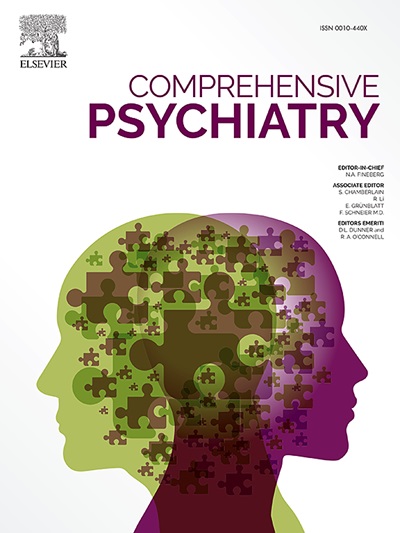Screening accuracy of the German version of the benzodiazepine self-report questionnaire
IF 4.2
2区 医学
Q1 PSYCHIATRY
引用次数: 0
Abstract
Background and aims
We aimed to assess the accuracy for the German version of the Benzodiazepine Dependence Self-Report Questionnaire (Bendep-SRQ-GV) as a possible screening instrument for benzodiazepine or Z-drug substance use disorder.
Method
This study includes a convenience sample of adults who had used benzodiazepines or Z-drugs at least once in the last year. Participants were recruited through notice boards, social media, newspaper, and a digital health information platform. All participants answered the Bendep-SRQ-GV and were assessed for benzodiazepine or Z-drug substance use disorder using the Structured Clinical Interview for DSM-5 Disorders – Clinical Version. We performed receiver operating characteristics curve analyses and calculated the area under the curve (AUC).
Results
42 out of 60 participants fulfilled the criteria for benzodiazepine or Z-drug substance use disorder according to Structured Clinical Interview. AUCs varied among the 4 subscales of the Bendep-SRQ-GV: Problematic Use (0.893 [0.819–0.975]), Preoccupation (0.751 [0.609–0.892]), Lack of Compliance (0.804 [0.699–0.919]), Withdrawal (0.743 [0.622–0.864]) and Total Score (0.860 [0.762–0.963]). For Problematic Use and Total Score selected cut-offs (5.5 and 16.5) showed best results: sensitivity (83 % [71–93 %] and 79 % [67–90 %]), high specificity (83 % [61–100 %] and 83 % [67–100 %], positive predictive value (92 % [84–100 %] and 92 % [83–100 %]), and negative predictive value (68 % [54–85 %] and 63 % [50–77 %]).
Discussion
The subscale Problematic Use and the Total Score seem promising for detecting benzodiazepine or Z-drug substance use disorder in adults. Precise cut-offs should be determined with a larger sample. The Bendep-SRQ-GV could be of great value as a screening questionnaire in clinical settings, counselling sites, and for scientific purposes.
德文版苯二氮卓类自我报告问卷的筛选准确性
背景与目的本研究旨在评估德文版苯二氮卓类药物依赖自我报告问卷(bendeep - srq - gv)作为苯二氮卓类药物或z类药物使用障碍筛查工具的准确性。方法本研究选取在过去一年中至少使用过一次苯二氮卓类药物或z类药物的成年人作为方便样本。参与者是通过布告栏、社交媒体、报纸和数字健康信息平台招募的。所有参与者都回答了bendeep - srq - gv,并使用DSM-5障碍-临床版结构化临床访谈评估苯二氮卓类或z -药物物质使用障碍。进行受试者工作特征曲线分析,计算曲线下面积(AUC)。结果根据结构化临床访谈,60名参与者中有42人符合苯二氮卓类药物或z类药物使用障碍标准。bendeep - srq - gv量表的auc分别为:问题使用(0.893[0.819-0.975])、关注(0.751[0.609-0.892])、缺乏依从性(0.804[0.699-0.919])、戒断(0.743[0.622-0.864])和总分(0.860[0.762-0.963])。对于有问题的使用和总分选择的截断值(5.5和16.5)显示出最佳结果:敏感性(83%[71 - 93%]和79%[67 - 90%]),高特异性(83%[61 - 100%]和83%[67 - 100%],阳性预测值(92%[84 - 100%]和92%[83 - 100%]),阴性预测值(68%[54 - 85%]和63%[50 - 77%])。问题使用量表和总分似乎有希望检测成人苯二氮卓类药物或z类药物使用障碍。精确的截止值应该用更大的样本来确定。bendeep - srq - gv可以作为临床环境、咨询场所和科学目的的筛查问卷,具有很大的价值。
本文章由计算机程序翻译,如有差异,请以英文原文为准。
求助全文
约1分钟内获得全文
求助全文
来源期刊

Comprehensive psychiatry
医学-精神病学
CiteScore
12.50
自引率
1.40%
发文量
64
审稿时长
29 days
期刊介绍:
"Comprehensive Psychiatry" is an open access, peer-reviewed journal dedicated to the field of psychiatry and mental health. Its primary mission is to share the latest advancements in knowledge to enhance patient care and deepen the understanding of mental illnesses. The journal is supported by a diverse team of international editors and peer reviewers, ensuring the publication of high-quality research with a strong focus on clinical relevance and the implications for psychopathology.
"Comprehensive Psychiatry" encourages authors to present their research in an accessible manner, facilitating engagement with clinicians, policymakers, and the broader public. By embracing an open access policy, the journal aims to maximize the global impact of its content, making it readily available to a wide audience and fostering scientific collaboration and public awareness beyond the traditional academic community. This approach is designed to promote a more inclusive and informed dialogue on mental health, contributing to the overall progress in the field.
 求助内容:
求助内容: 应助结果提醒方式:
应助结果提醒方式:


